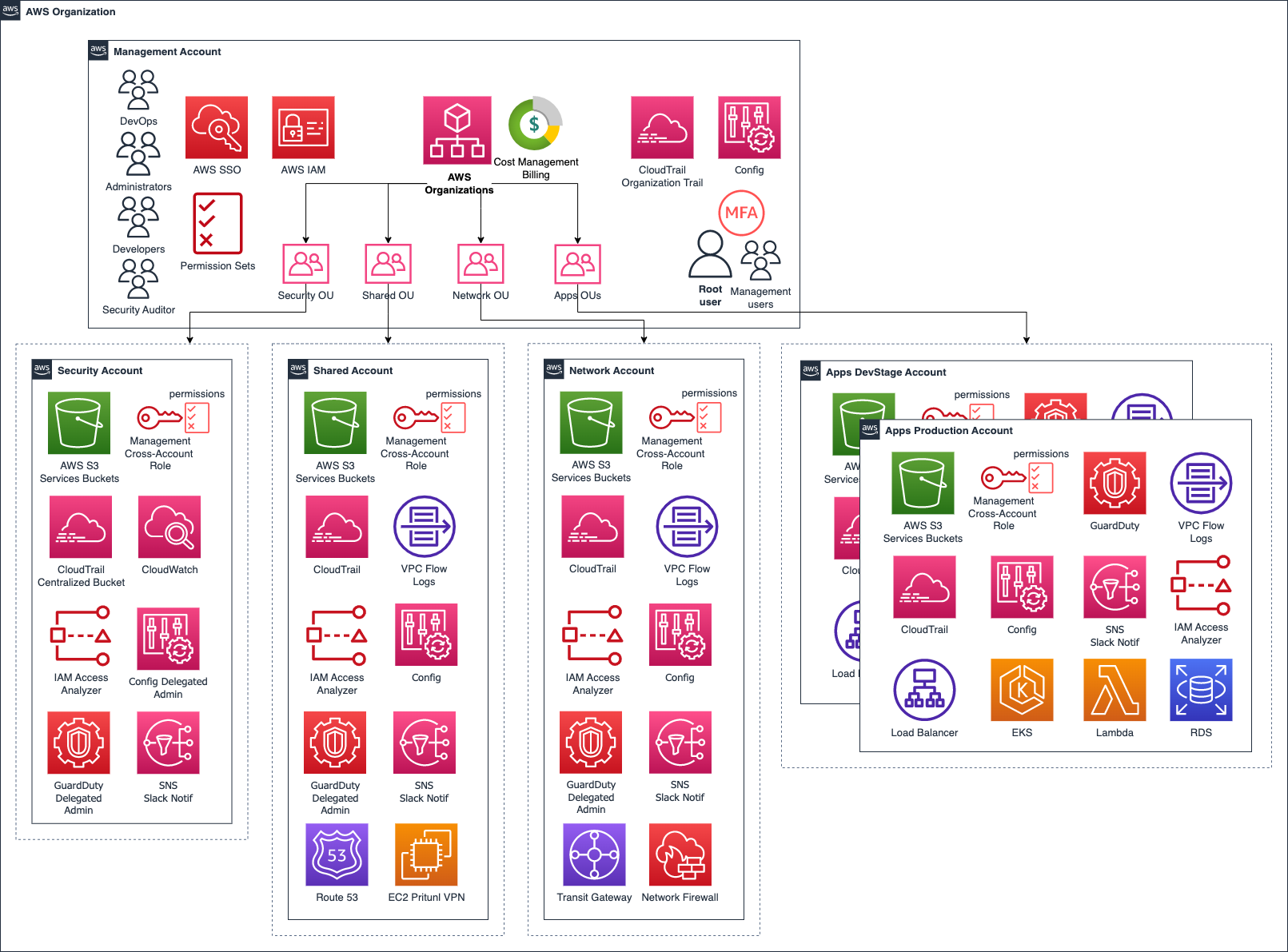Project Structure ¶
Files/Folders Organization ¶
The following block provides a brief explanation of the chosen files/folders layout, under every account (management,
shared, security, etc) folder you will see a service layer structure similar to the following:
MyExample project file structure
...
├── 📂 apps-devstg
│ ├── 📂 config
| │ ├── 📄 account.tfvars
| │ └── 📄 backend.tfvars
| ├── 📂 global
| │ └── 📂 base-identities
| ├── 📂 us-east-1
| │ ├── 📂 backups
| │ ├── 📂 base-certificates
| │ ├── 📂 base-network
| │ ├── 📂 base-tf-backend
| │ ├── 📂 cdn-s3-frontend
| │ ├── 📂 databases-aurora
| │ ├── 📂 databases-mysql
| │ ├── 📂 databases-pgsql
| │ ├── 📂 k8s-eks-demoapps
| │ ├── 📂 notifications
| │ ├── 📂 security-audit
| │ ├── 📂 security-base
| │ ├── 📂 security-certs
| │ ├── 📂 security-firewall
| │ ├── 📂 storage
| │ └── 📂 tools-cloud-nuke
| └── 📂 us-east-2
| ├── 📂 k8s-eks
| ├── 📂 security-compliance
| └── 📂 security-keys
├── 📂 apps-prd
│ ├── 📂 config
| │ ├── 📄 account.tfvars
| │ └── 📄 backend.tfvars
│ ├── 📂 global
| │ └── 📂 base-identities
│ └── 📂 us-east-1
| ├── 📂 backups
| ├── 📂 base-network
| ├── 📂 base-tf-backend
| ├── 📂 cdn-s3-frontend
| ├── 📂 k8s-eks
| ├── 📂 notifications
| ├── 📂 security-audit
| ├── 📂 security-base
| ├── 📂 security-certs
| ├── 📂 security-compliance
| └── 📂 security-keys
├── 📄 build.env
├── 📄 build.py
├── 📂 config
│ └── 📄 common.tfvars
├── 📂 management
│ ├── 📂 config
| │ ├── 📄 account.tfvars
| │ └── 📄 backend.tfvars
│ ├── 📂 global
| │ ├── 📂 base-identities
| │ ├── 📂 cost-mgmt
| │ ├── 📂 organizations
| │ └── 📂 sso
│ ├── 📂 us-east-1
| │ ├── 📂 backups
| │ ├── 📂 base-tf-backend
| │ ├── 📂 notifications
| │ ├── 📂 security-audit
| │ ├── 📂 security-base
| │ ├── 📂 security-compliance
| │ ├── 📂 security-keys
│ └── 📂 us-east-2
| └── 📂 security-monitoring
├── 📂 network
│ ├── 📂 config
| │ ├── 📄 account.tfvars
| │ └── 📄 backend.tfvars
│ ├── 📂 global
| │ └── 📂 base-identities
│ ├── 📂 us-east-1
| │ ├── 📂 base-network
| │ ├── 📂 base-tf-backend
| │ ├── 📂 network-firewall
| │ ├── 📂 notifications
| │ ├── 📂 security-audit
| │ ├── 📂 security-base
| │ ├── 📂 security-compliance
| │ ├── 📂 security-keys
| │ └── 📂 transit-gateway
│ └── 📂 us-east-2
| ├── 📂 base-network
| ├── 📂 network-firewall
| ├── 📂 security-compliance
| ├── 📂 security-keys
| └── 📂 transit-gateway
├── 📂 security
│ ├── 📂 config
| │ ├── 📄 account.tfvars
| │ └── 📄 backend.tfvars
│ ├── 📂 global
| │ └── 📂 base-identities
│ ├── 📂 us-east-1
| │ ├── 📂 base-tf-backend
| │ ├── 📂 firewall-manager
| │ ├── 📂 notifications
| │ ├── 📂 security-audit
| │ ├── 📂 security-base
| │ ├── 📂 security-compliance
| │ ├── 📂 security-keys
| │ └── 📂 security-monitoring
│ └── 📂 us-east-2
| ├── 📂 security-audit
| ├── 📂 security-compliance
| └── 📂 security-monitoring
└── 📂 shared
├── 📂 config
│ ├── 📄 account.tfvars
│ └── 📄 backend.tfvars
├── 📂 global
| ├── 📂 base-dns
| └── 📂 base-identities
├── 📂 us-east-1
| ├── 📂 backups
| ├── 📂 base-network
| ├── 📂 base-tf-backend
| ├── 📂 container-registry
| ├── 📂 ec2-fleet
| ├── 📂 k8s-eks
| ├── 📂 k8s-eks-demoapps
| ├── 📂 k8s-eks-prd
| ├── 📂 notifications
| ├── 📂 security-audit
| ├── 📂 security-base
| ├── 📂 security-compliance
| ├── 📂 storage
| ├── 📂 tools-cloud-scheduler-stop-start
| ├── 📂 tools-eskibana
| ├── 📂 tools-github-selfhosted-runners
| ├── 📂 tools-jenkins
| ├── 📂 tools-managedeskibana
| ├── 📂 tools-prometheus
| ├── 📂 tools-vault
| ├── 📂 tools-vpn-server
| └── 📂 tools-webhooks
└── 📂 us-east-2
├── 📂 base-network
├── 📂 container-registry
├── 📂 security-compliance
├── 📂 security-keys
├── 📂 tools-eskibana
└── 📂 tools-prometheus
Configuration files are organized by environments (e.g. dev, stg, prd), and service type, which we call layers (identities, organizations, storage, etc) to keep any changes made to them separate. Within each of those layers folders you should find the OpenTofu files that are used to define all the resources that belong to such account environment and specific layer.
Project file structure
An extended project file structure could be found here While some other basic concepts and naming conventions in the context of Leverage like "project" and "layer" here

NOTE: As a convention folders with the -- suffix reflect that the resources are not currently
created in AWS, basically they've been destroyed or not yet exist.
Such layer separation is meant to avoid situations in which a single folder contains a lot of resources.
That is important to avoid because at some point, running leverage tofu plan / apply starts taking
too long and that becomes a problem.
This organization also provides a layout that is easier to navigate and discover. You simply start with the accounts at the top level and then you get to explore the resource categories within each account.